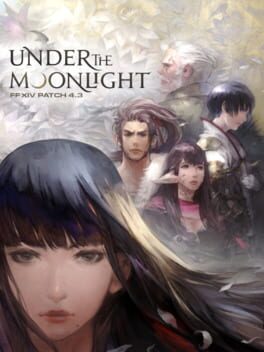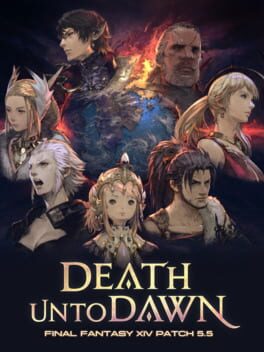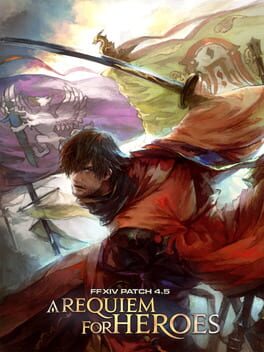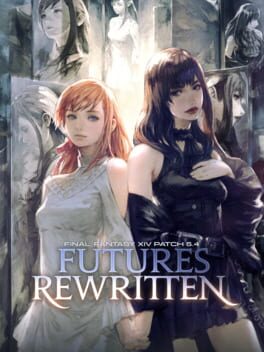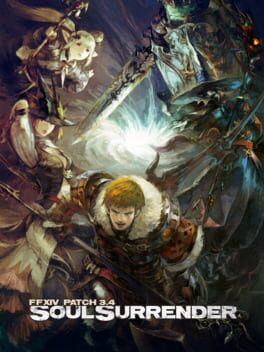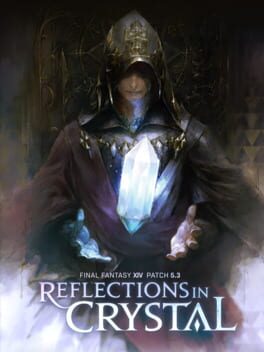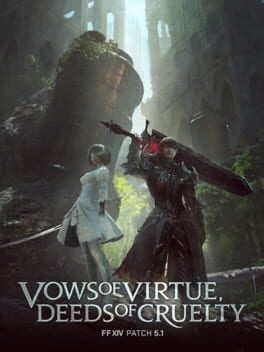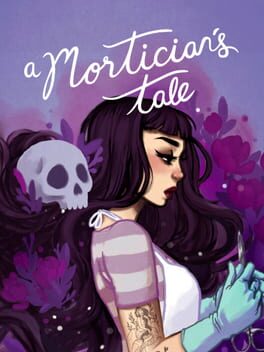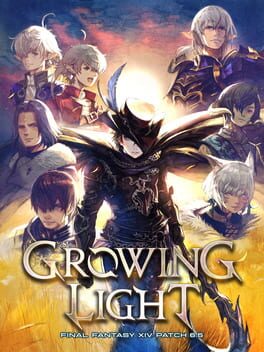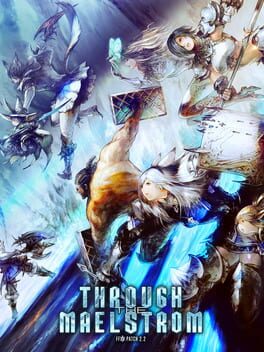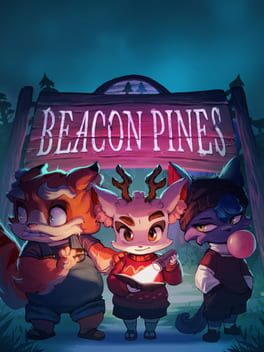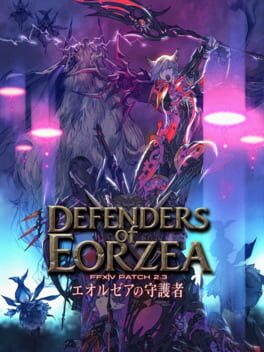guimachiavelli
As expected, Doma/Yotsuyu's storyline keeps getting worse. If 4.1 was about the Sultana maturing by learning how to get a good deal out of helping refugees, this one is about how a good Yotsuyu is am obedient and childlike Yotsuyu. There is something really dark about her "redemption" being removing all agency from her—mirroring the abuse that made her into the monster from 4.0.
Those considerations aside, 4.2 seems structurally identical to 3.2: preparing the stage for the following patch which will effectively end Stormblood proper.
Those considerations aside, 4.2 seems structurally identical to 3.2: preparing the stage for the following patch which will effectively end Stormblood proper.
Yotsuyu's storyline comes to its end, thankfully. The summary is: according to the Good Guys™ (that's us) the only Yotsuyu worth saving is an Yotsuyu without any agency. She is good as a quiet, helpless victim; the moment she manifests her own will and desires, she deserves to die.
Honestly, by the end of the patch I was 100% rooting for her—as in, not for her "redemption", but for her to kick my Warrior of Light's arse due to complicity. I am happy she at least got to murder a few people. It seemed fair, all things considered.
Honestly, by the end of the patch I was 100% rooting for her—as in, not for her "redemption", but for her to kick my Warrior of Light's arse due to complicity. I am happy she at least got to murder a few people. It seemed fair, all things considered.
This patch gives me the feeling I won't enjoy Endwalker that much. FFXIV villains work best when they have some degree of grey to them: from the first time Elidibus came into play he was interesting because he seemed mostly reasonable; Emet-Selch was brilliant because he was not laughing maniacally sitting on his throne made out of dead babies. Zenos' "hunt" is wholly unconvincing and Fandaniel's evil psychopathic jester shtick is frankly exhausting and overplayed.
The towers are sort of visually interesting in their fleshy design, but the fact they spit out discount bin primals is narratively difficult. They go from world-changing creatures to…trash mobs, basically—the supposedly giga-powerful Lunar Bahamut barely qualifies as a dungeon boss now. After years of worldbuilding around the awesome power of primals, this leaves a vacuum that will be very hard to fill.
The towers are sort of visually interesting in their fleshy design, but the fact they spit out discount bin primals is narratively difficult. They go from world-changing creatures to…trash mobs, basically—the supposedly giga-powerful Lunar Bahamut barely qualifies as a dungeon boss now. After years of worldbuilding around the awesome power of primals, this leaves a vacuum that will be very hard to fill.
Finally, Stormblood is done.
Absolute high-point of 4.x: seeing Varis absolutely destroying the Eorzean Alliance's rhetoric of "we're 100% always the good guys". The Emperor does have some very funny ideas about what is going to happen to the world once the Ascians get what they want—but, then again, when has eugenics been remotely logic?
This final patch is also narratively very well-crafted: the dwindling Scions together with the formal return of Zenos builds up to a quick and satisfying climax, which itself leads us smoothly into the doors of 5.0.
Absolute high-point of 4.x: seeing Varis absolutely destroying the Eorzean Alliance's rhetoric of "we're 100% always the good guys". The Emperor does have some very funny ideas about what is going to happen to the world once the Ascians get what they want—but, then again, when has eugenics been remotely logic?
This final patch is also narratively very well-crafted: the dwindling Scions together with the formal return of Zenos builds up to a quick and satisfying climax, which itself leads us smoothly into the doors of 5.0.
I was quite honestly ecstatic with the story finally tackling tempering and that someone cared enough to make it their life's mission to revert the process. If anything, it seems like the questline resolves too quickly. An incurable affliction that was commonly solved through execution (that moment in which Thancred offhandedly mentions Ul'dah would put all people we saw being tempered by Ifrit to the sword was one the darkest throughout ARR, imho), suddenly curable with an almost 100% success rate, given enough resources.
I also appreciated how 5.x in general has been slowly bringing "beastmen" into the fold as sentient beings worthy of respect. I 100% do not trust any Eorzean nation to not betray them again, given how racist they all are, but it's very nice that the narrative finally addresses the issue with some degree of attention.
I also appreciated how 5.x in general has been slowly bringing "beastmen" into the fold as sentient beings worthy of respect. I 100% do not trust any Eorzean nation to not betray them again, given how racist they all are, but it's very nice that the narrative finally addresses the issue with some degree of attention.
We are now essentially done with Heavensward and Ishgard moves from main plot element to useful bystander happy to lend a hand when things need a moving along. On their own, the Warriors of Darkness episodes are weirdly disjointed: they hint at so many important things that could be milked for hours of story, but go away in the blink of an eye.
I know everything here are seeds for 5.0. I wonder how people experienced it at the time of release—was it perceived as a grandiose but fleeting way of putting the subject of Minfillia to a final and definitive rest? Were players annoyed at this episode coming seemingly out of nowhere and disappearing just as quickly?
I know everything here are seeds for 5.0. I wonder how people experienced it at the time of release—was it perceived as a grandiose but fleeting way of putting the subject of Minfillia to a final and definitive rest? Were players annoyed at this episode coming seemingly out of nowhere and disappearing just as quickly?
This review contains spoilers
Finally we begin to leave Stormblood behind and the story's messy and failed attempts at geopolitics. The most interesting part comes at the end, when we discover the origins of the Garlean empire.
Having the whole nation being an Ascian operation is sort of an elegant solution that allows the writers to move back to territory more fitting for a Final Fantasy game—the Empire is bad not because people can be cruel and genocidal, but because of supernaturally mean creatures. As weak as that premise is, it allows the story to focus on the fantasy elements, from which FFXIV seems to be able to derive better characters.
Having the whole nation being an Ascian operation is sort of an elegant solution that allows the writers to move back to territory more fitting for a Final Fantasy game—the Empire is bad not because people can be cruel and genocidal, but because of supernaturally mean creatures. As weak as that premise is, it allows the story to focus on the fantasy elements, from which FFXIV seems to be able to derive better characters.
5.3 sort of perfectly encapsulates everything I love AND dislike about this game. It is FFXIV's highest point.
Narratively, there's just so much good stuff going on, all beats expertly crafted so they deliver continuous emotional gut punches. The pathos of the Unsundered and the way Elidibus wavers under the weight of mission he can no longer understand, for instance. The Scions' farewells are equally beautiful and bittersweet—this was the moment all their talking about wanting to save the world because they love it unconditionally really felt tangible, where we got to see how saddened they were to leave their friends of the First. I might have shed a few tears while watching Seto's cutscenes. These are the reasons why I play and love this game.
But then there are the actual gameplay bits. The trial encapsulated everything I dislike about playing MMOs. Mechanics stacked on top of mechanics, making it hard to find my own character in the middle of all the flashy stuff going on, let alone understand what I was supposed to do. While of course keeping some sort of awareness as to what the other 7 players were doing, maintaining oGCDs on cooldown, and performing a decent enough rotation. For me, this sort of situation feels more like artificial difficulty than an interesting challenge, even more so because it felt more like a cross of an eyesight test and social challenge than a fun game: who has the shiny stack up marker and who has the shiny move away marker amidst the 5 other shiny explosions? How to get these players to understand they shouldn't stay close together? Is the villain saying something relevant? Who knows, ain't nobody got time for that when all party members are at <10% HP. I don't get anxious about these things anymore; my only reaction is "I hope this ends soon".
Narratively, there's just so much good stuff going on, all beats expertly crafted so they deliver continuous emotional gut punches. The pathos of the Unsundered and the way Elidibus wavers under the weight of mission he can no longer understand, for instance. The Scions' farewells are equally beautiful and bittersweet—this was the moment all their talking about wanting to save the world because they love it unconditionally really felt tangible, where we got to see how saddened they were to leave their friends of the First. I might have shed a few tears while watching Seto's cutscenes. These are the reasons why I play and love this game.
But then there are the actual gameplay bits. The trial encapsulated everything I dislike about playing MMOs. Mechanics stacked on top of mechanics, making it hard to find my own character in the middle of all the flashy stuff going on, let alone understand what I was supposed to do. While of course keeping some sort of awareness as to what the other 7 players were doing, maintaining oGCDs on cooldown, and performing a decent enough rotation. For me, this sort of situation feels more like artificial difficulty than an interesting challenge, even more so because it felt more like a cross of an eyesight test and social challenge than a fun game: who has the shiny stack up marker and who has the shiny move away marker amidst the 5 other shiny explosions? How to get these players to understand they shouldn't stay close together? Is the villain saying something relevant? Who knows, ain't nobody got time for that when all party members are at <10% HP. I don't get anxious about these things anymore; my only reaction is "I hope this ends soon".
This patch starts well enough, moving us towards the quest of getting the Scions back to the Source, as well as moving our focus back to whatever mess is going on in Garlemald. Sadly, or perhaps predictably, this is soon cast aside in favour of accompanying the family-friendly political changes in post-Vauthry Eulmore.
As with other x.1 patches, 5.1 seems to be meant as a light and inconsequential sprinkling of new content, a sort of palate cleanser before picking things up in earnest again with x.2 and effectively finishing the expansion's main storyline with x.3.
As with other x.1 patches, 5.1 seems to be meant as a light and inconsequential sprinkling of new content, a sort of palate cleanser before picking things up in earnest again with x.2 and effectively finishing the expansion's main storyline with x.3.
2017
This chapter reaches its very predictable ending, with everyone who's still alive redeemed, and a clear narrative thread left alone but ready to be picked back up in a future expansion. It's as fulfilling as this sort of in-between content can be, and I'm honestly overjoyed I won't have to endure the cringe of Zero tipping her hat every time people talk about feelings any longer. I'm curious about Dawntrail, but this curiosity is tempered by my feelings about gameplay.
I find myself again dreaming about this exact game, with the exact same amount of content, the same story, classes, characters, lore, and so on, but as a single player experience not beholden to the requirements of a traditional MMO.
Though I can appreciated FFXIV's gameplay in small doses, I once more reach the conclusion I just…deeply dislike it. The scripted nature of its fundamental mechanics (every class has its own rotation and deviating from it is always bad) and the very sparkly Simon Says of trials and raids, paired with the inevitable focus on optimisation that is part and parcel of MMOs, just makes for a miserable experience for me.
I find myself again dreaming about this exact game, with the exact same amount of content, the same story, classes, characters, lore, and so on, but as a single player experience not beholden to the requirements of a traditional MMO.
Though I can appreciated FFXIV's gameplay in small doses, I once more reach the conclusion I just…deeply dislike it. The scripted nature of its fundamental mechanics (every class has its own rotation and deviating from it is always bad) and the very sparkly Simon Says of trials and raids, paired with the inevitable focus on optimisation that is part and parcel of MMOs, just makes for a miserable experience for me.
tl;dr: I hate MMOs and will never play one again, but experiencing FFXIV's world and story is very much worth the bother for me.
After playing ARR (2.0), Heavensward (3.0), Stormblood (4.0), and now Shadowbringers (5.0) to Main Quest completion, across different roles (tank in ARR, DPS in HW, healer in SB, and DPS once again in ShB) and engaging in quite a few secondary activities (alliance raids, regular raids, optional trials/dungeons, blue sidequests, yellow sidequests, minor crafting, daily roulettes) I think I can say I hate MMOs.
My grievances go from culture (MMOs seem to encourage optimised play and I do not play videogames for optimisation; in single-player games that's a non-issue, but playing with other people means I need to at least meet them halfway), to gameplay (dungeons and trials were a price I paid to get on with the story and I seldom felt I was actually enjoying them), to socialisation (I prefer to socialise in outside of computers), to the mechanics of online gaming (let me tell you, dealing with latency is not a newfound pleasure, and waiting 30 minutes in queue in between mandatory multiplayer content does not help the narrative flow). This only became more clear with Shadowbringers, when running the game almost completely with NPCs becomes a reality and I could selfishly experience the game the way I wanted.
Even then, I stuck with FFXIV till now and will continue onwards to Endwalker. Beneath all those things I do not like, this is still a Final Fantasy game with all the bits I love about Final Fantasy. Even more than that, it is everything I love about this series given enormous scope and time, taking its story to a completely different level than what a self-contained game, with its limited amount of development hours and logistic/economic constraints, can achieve. The writers take their time setting up every major and minor narrative beat, achieving an impressive degree of narrative consistency and quality—not everything is great, but all these parts taken together make for an experience that is very hard to find in other games. Ever since the 2.x patches, every bit of content I played, from optional fetch quests to the main story beats, seems carefully designed and coherent with the overarching narrative and world.
Shadowbringers specifically is amazing. It learns from what worked in the past stories and put all its efforts there: charismatic characters, complex villains (excluding the final moments leading to the boss fight in which he devolves to run-of-the-mill bad guy yelling about infinite power, Emet-Selch is possibly one of the best JRPG villains I have encountered), fantastic worlds, and a plot that rarely flounders (Il Mheg being the only moment I really got bored).
After playing ARR (2.0), Heavensward (3.0), Stormblood (4.0), and now Shadowbringers (5.0) to Main Quest completion, across different roles (tank in ARR, DPS in HW, healer in SB, and DPS once again in ShB) and engaging in quite a few secondary activities (alliance raids, regular raids, optional trials/dungeons, blue sidequests, yellow sidequests, minor crafting, daily roulettes) I think I can say I hate MMOs.
My grievances go from culture (MMOs seem to encourage optimised play and I do not play videogames for optimisation; in single-player games that's a non-issue, but playing with other people means I need to at least meet them halfway), to gameplay (dungeons and trials were a price I paid to get on with the story and I seldom felt I was actually enjoying them), to socialisation (I prefer to socialise in outside of computers), to the mechanics of online gaming (let me tell you, dealing with latency is not a newfound pleasure, and waiting 30 minutes in queue in between mandatory multiplayer content does not help the narrative flow). This only became more clear with Shadowbringers, when running the game almost completely with NPCs becomes a reality and I could selfishly experience the game the way I wanted.
Even then, I stuck with FFXIV till now and will continue onwards to Endwalker. Beneath all those things I do not like, this is still a Final Fantasy game with all the bits I love about Final Fantasy. Even more than that, it is everything I love about this series given enormous scope and time, taking its story to a completely different level than what a self-contained game, with its limited amount of development hours and logistic/economic constraints, can achieve. The writers take their time setting up every major and minor narrative beat, achieving an impressive degree of narrative consistency and quality—not everything is great, but all these parts taken together make for an experience that is very hard to find in other games. Ever since the 2.x patches, every bit of content I played, from optional fetch quests to the main story beats, seems carefully designed and coherent with the overarching narrative and world.
Shadowbringers specifically is amazing. It learns from what worked in the past stories and put all its efforts there: charismatic characters, complex villains (excluding the final moments leading to the boss fight in which he devolves to run-of-the-mill bad guy yelling about infinite power, Emet-Selch is possibly one of the best JRPG villains I have encountered), fantastic worlds, and a plot that rarely flounders (Il Mheg being the only moment I really got bored).
As with the previous patch, it's interesting to see the story slowly developing and balancing different branches that will probably converge to trigger the events that lead to Heavensward. I do not care particularly about the threads regarding Ascians, but I like the fact the treatment of beastmen is highlighted as a major, if not the sole, reason behind Eorzea facing catastrophe again and again. Limsa Lominsa clearly sees Sahagin and Kobolds as nuisances instead of creatures with as much right to live as them, then complains when these same creatures try to murder their oppressor. I'm, like, 70% team beastmen at this point.
From a complete casual viewpoint, Full Party content is absolute chaos. I can hardly imagine how messed up Alliance Raids are.
From a complete casual viewpoint, Full Party content is absolute chaos. I can hardly imagine how messed up Alliance Raids are.
2022
The way the narrative unfolds is very interesting. Though it might look like the game allows the player to choose how the story will develop, these choices are by and large oblique ways of delivering information piecemeal in a climactic manner while keeping the final, successful branch from breaking under its own weight. The end result is quite satisfying, creating this sort of spiral storytelling structure where we get progressively closer to the "truth".
The story continues advancing, setting myriad threads that cross each other, hinting at possible connections and developments, but never really coming together. This weaving is interesting, in some respects: the element that seems to unite all those disparate threads right now is the overconfidence, the overestimation of everyone's capabilities. The Warrior of Light will never lose, the Scions are all 100% trustworthy and infallible—so much so that everyone's totally OK with a rich 16-year-old assembling his own paramilitary group partly funded by dirty money.
As far as gameplay goes, it's hard to really evaluate any FFXIV patch years after its initial release: though a player follows each patch's story linearly at their own pace, mechanics always follow the latest update (currently 6.28, I believe).
As far as gameplay goes, it's hard to really evaluate any FFXIV patch years after its initial release: though a player follows each patch's story linearly at their own pace, mechanics always follow the latest update (currently 6.28, I believe).

